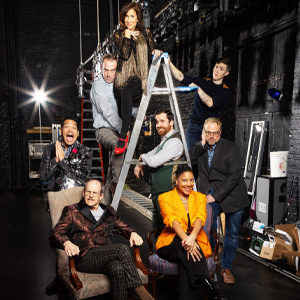Expanding the Canon and the Community: In the Heights at PSF
by Jason King Jones
In the Heights is a revolutionary musical that paved the way for a new sound and new community of artists on Broadway. I am excited to produce this musical that changed the American stage and is still influencing the genre more than two decades after its first performance.
Why does a rap and hip-hop infused musical about a small immigrant neighborhood in New York City matter so much? And why am I so excited to share it with you and the rest of the PSF audience? Read on, and you’ll see.
“Lights up on Washington Heights!”
In the Heights is a celebration of community. It focuses on a small population scraping together a living in the Washington Heights neighborhood of New York City. These people include Usnavi de la Vega, the owner of “just another dime-a-dozen mom-and-pop stop-and-shop” who operates the store with his cousin, Sonny; Vanessa, an employee of Daniela’s Hair Salon, who is desperate to move downtown; and the Rosario family, who own and operate the Rosario Car Service and are celebrating their daughter Nina’s recent return from her first year at Stanford.
The neighborhood is tightly-knit: they celebrate together, mourn together, and struggle together to eke out a living as prices continue to climb, gentrification creeps in, and outside forces make daily living more challenging. This is a story with which I identify strongly, and I suspect it’s a story that speaks to nearly anyone who has had to make sacrifices for their future and their family.
The story of how this musical was created is in itself one that exemplifies the hard-working, dream-following narrative that is woven into the American experience.
“The first to go to college…”
Lin-Manuel Miranda first produced a version of In the Heights during his sophomore year at Wesleyan University in 1999. It was inspired by the Jonathan Larson hit RENT and featured a love triangle between Nina Rosario, Benny (the Rosario Car Service employee), and Nina’s brother, Lincoln. While Lincoln was eventually written out of the script after Quiara Alegría Hudes joined the team to craft the book, the musical always had a variety of styles, including salsa, reggaeton, traditional Broadway show tunes, rap, and hip-hop. It was this unique blend of sounds—reflective of Miranda’s own experience living in northern New York City— that set apart In the Heights from any other musical.
After college, Miranda returned to New York and, while working as a seventh-grade English teacher, he collaborated with fellow Wesleyan University alums and Hudes to re-write the musical and present multiple workshops in the basement of The Drama Bookshop. It was during this time that the focus of the narrative shifted from a love triangle to the community itself, and Miranda’s secondary character, bodega owner Usnavi, took more prominence in the narrative. Ironically, Miranda, who originated the role of Usnavi, related more to Nina—the first-year college student struggling to live up to the expectations of her family and not fully fitting into life on an elite college campus.
After multiple drafts and workshops, In the Heights premiered Off-Broadway in 2007, where it garnered two Drama Desk Awards and was nominated for seven others. It transferred to Broadway a year later, and through its music, positivity, and authentic focus on the Latino community, In the Heights changed the course of American musical theatre. Fifteen years later, In the Heights has toured the US, had major productions across the globe, and was adapted into a major motion picture. Miranda himself has gone on to write regularly for Disney, including music for Moana and Encanto. His musical adaptation of Ron Chernow’s biography of Alexander Hamilton has elevated Miranda to the pantheon of legendary writers, and he is considered by some to be the Shakespeare of our time.
“Everybody’s got a job, everybody’s got a dream.”
In the opening number of the musical, also titled “In the Heights,” Usnavi introduces the audience to all the main characters. We learn that the people in this neighborhood are the backbone of New York: working-class people who get up early, go to work, and make sacrifices for their family. Usnavi describes his neighbors: “everybody’s got a job, everybody’s got a dream.” Although I was raised far from a daily view of the George Washington Bridge, I relate strongly to the people in this play.
I grew up in rural Southwest Missouri. My grandparents were farmers, and my father, after a stint in the Navy during Vietnam, was a cowboy with a dream of becoming a large-animal vet. That dream never materialized, and he ultimately took a job as a mail handler for the US Postal Service, working the second shift to provide for his family. During the weekends we spent time with our extended family; sometimes we would help harvest my grandparents’ crops, sometimes we’d chop and gather wood for the winter, sometimes the cousins would simply play whatever imagined game we could devise in the moment. On its face, my rural experience doesn’t match at all with residents of Washington Heights, but when I experience this musical, I relate to the characters’ working-class struggles, their reliance on their community for support and connection, their dreams to move beyond their own small community to find a future elsewhere, and (as one of those people who left their hometown) the pressure they feel to live up to others’ expectations.
For those whose families have a more recent experience of immigrating to the United States, this musical takes on even greater significance, with fresh dreams for the “land of opportunity,” recent memories of another home, and unique challenges to chart a new course in a new country.
“I’m switchin’ up the beat.”
As someone who has loved Shakespeare’s language since I was a teenager, I see many parallels between the Bard’s crafting of language and Miranda’s lyrical dexterity.
Shakespeare’s plays were meant to be performed, his verse and prose meant to be heard out of the mouths of actors and received by a live audience made up of people from various classes and education levels. The average Elizabethan person on the street didn’t speak in iambic pentameter and rhyming couplets, yet Shakespeare was able to harness the energy of the ever-evolving English language, play with it, coin new phrases, and create incredible stories with characters speaking a rich and satisfyingly complex version of the common tongue.
Lin-Manuel Miranda does a 21st-century-version of the same thing with his hip-hop and rap-infused lyrics. For example, in a key moment in Act 2, the neighborhood has lost electricity, and people, including Sonny, are fed up. Usnavi responds with the following spoken-word lyrics:
Maybe you’re right, Sonny. Call in the coroners!
Maybe we’re powerless, a corner full
of foreigners.
Maybe this neighborhood’s changing forever,
Maybe tonight is our last night together. However:
How do you wanna face it?
Do you wanna waste it?
When the end is so close you can taste it?
Y’all could cry with your head in the sand.
I’m-a fly this flag that I got in my hand!
Just like with Shakespeare, if you simply read this text without speaking it aloud, you might miss some of the oratorical and rhetorical power Miranda is harvesting. He’s combining three poetic elements simultaneously: slant rhymes (words that nearly rhyme together), compound rhymes (multi-syllabic), and assonance (rhyming vowel sounds). He repeats the structure to add rhetorical power (“coroners-corners-foreigners” plus “forever-together-however”), setting up the argument that he then knocks down with the triple question that rhymes “face it,” “taste it,” and “waste it.” He then offers an alternative course of action in the final couplet. I love unpacking and experiencing this text just as much as I love unpacking and experiencing Shakespeare’s language.
“We’re home!”
When I interviewed for the opportunity to co-lead PSF with Casey Gallagher, I was asked what shows I might want to produce. In the Heights was the first on the list. I couldn’t be more excited to be sharing this story, this music, and this family of characters with you. I encourage you to lean in, open your hearts, and welcome Washington Heights into the PSF community. ■












